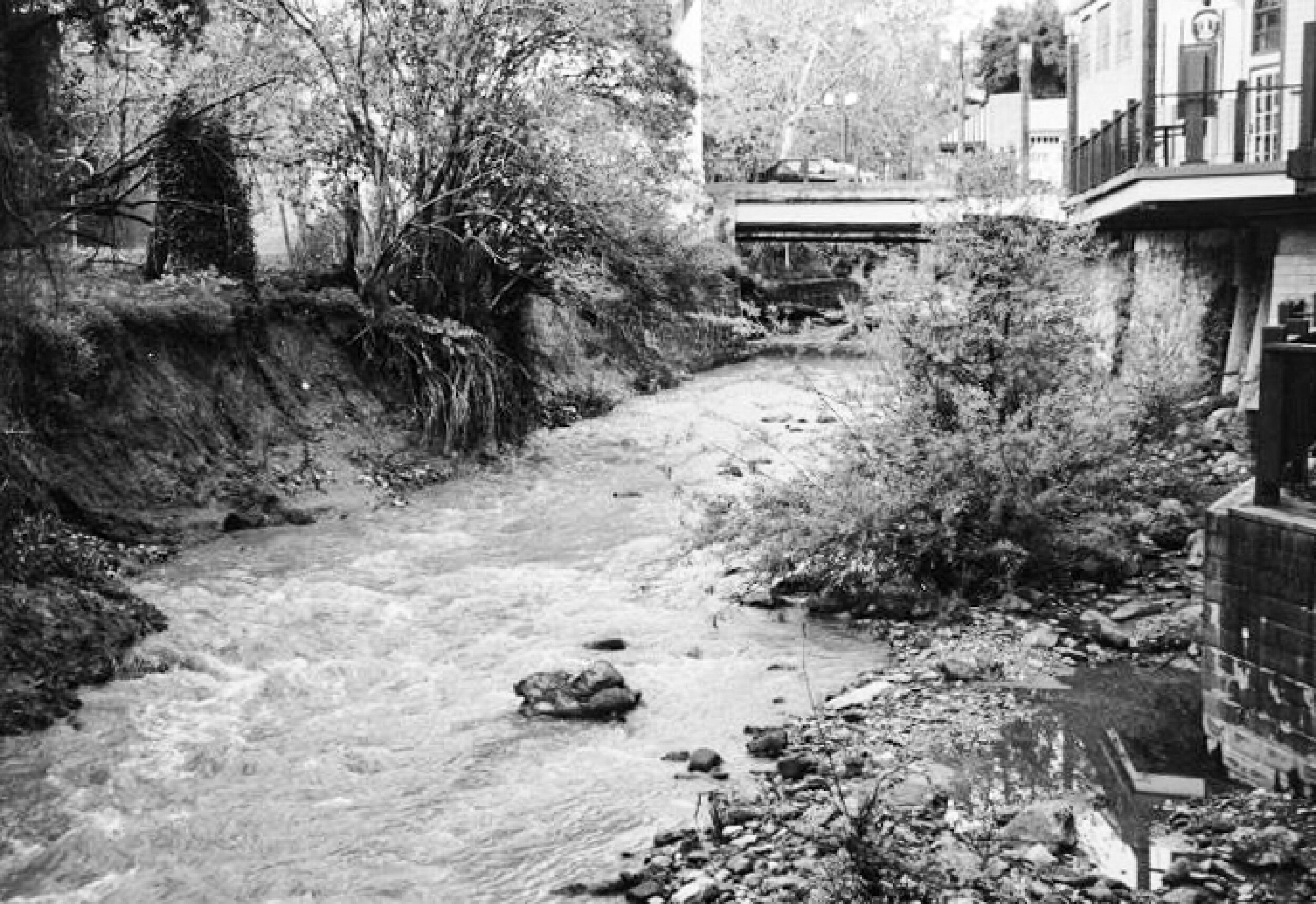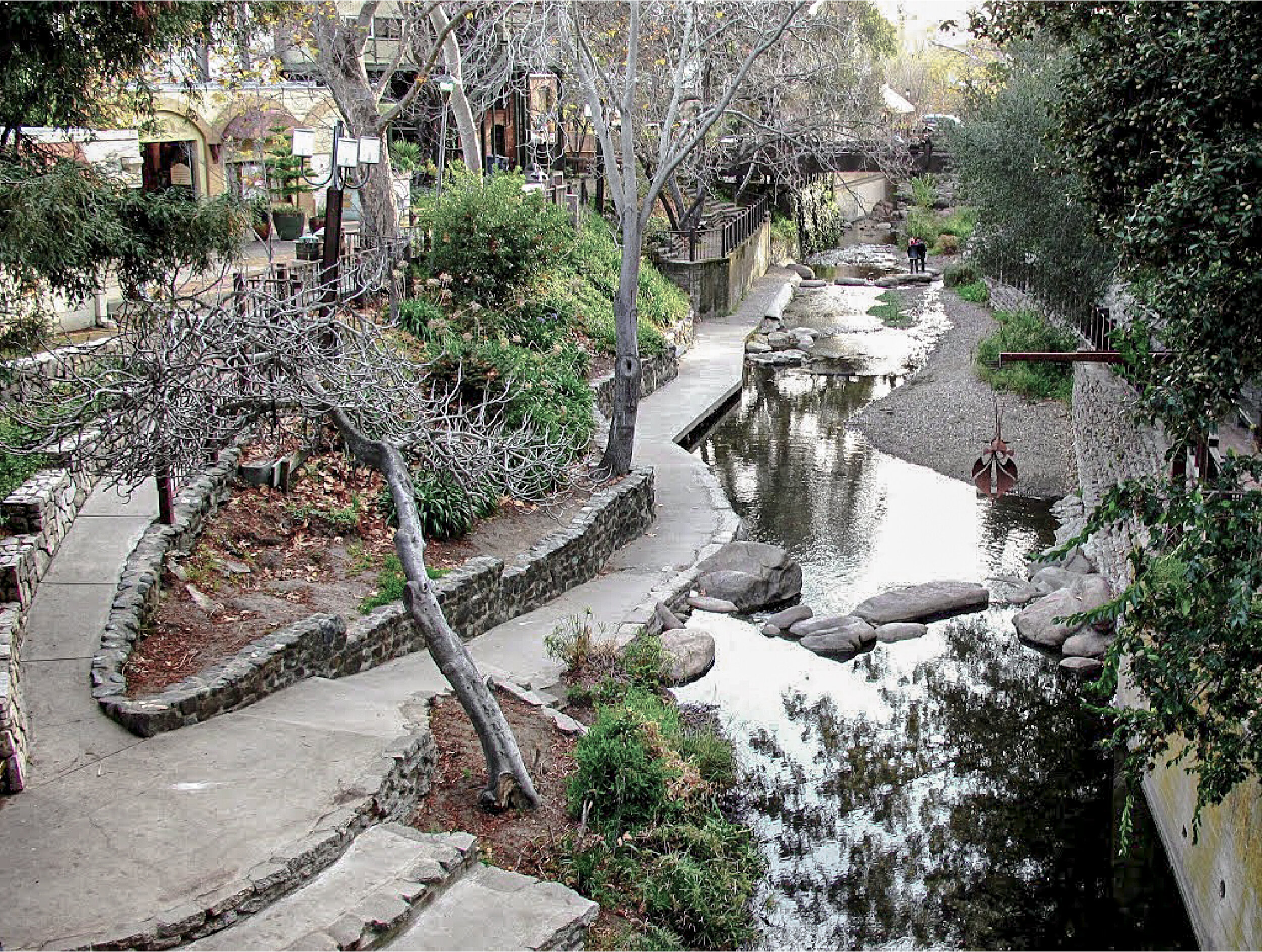San Luis Obispo Creek
Location: San Luis Obispo, CA
Length: 600 ft
Cost: $100k
Year: 1971
Efforts on San Luis Obispo Creek in San Luis Obispo, CA show us the power of protecting our urban creeks. Residents rallied around the creek, preventing its burial under a parking lot, and restoring its channel as a community amenity.
San Luis Obispo Creek flows through the ancestral lands of the Northern Chumash and Obispeño Territory [01]. Today, it winds through residential, commercial, and industrial areas in the heart of the City of San Luis Obispo. Filled with old tires, car parts, and trash, the creek was treated poorly through much of the 20th century. Banks were highly eroded and habitat value was extremely low.
In the 1950s, students from a local community college suggested beautifying the struggling downtown by closing a street to create a pedestrian plaza around the creek. The proposal gained attention, but city officials were opposed to closing the busy street. In the 1960s, two blocks of San Luis Obispo Creek were covered over for a parking lot. By the 1970s, business owners called for an additional parking lot—which would cover the rest of the creek—to increase visitation at their establishments.
The creek wasn’t perceived as a community asset. Buildings faced the opposite direction, towards the street. The creek was neglected and avoided.
Students at California Polytechnic State University and community residents saw the creek as an opportunity for urban revitalization and habitat restoration, referencing previous efforts from the 1950s. They would eventually defeat the ballot initiative that proposed burying the creek and encouraged the city to pursue stream restoration instead [02].
Property owners and merchants were reluctant to support restoration because of concerns regarding flooding, access, and safety. To represent all voices, a committee was formed and included downtown merchants, City officials, and community leaders. The committee’s goal was to create a design plan that served everyone. The plan gained consensus to widen the floodplain and stabilize the stream banks. It avoided the typical concrete-lined, trapezoidal channel that was standard at the time. Rather, terraced stone walls would be used to accommodate high winter flows.
Efforts centered around the historic Spanish Mission as a new downtown center. The Mission was erected in 1772 [02]. Mission Plaza, surrounding the historic building, was transformed into a vibrant green space. The street around the area was closed for pedestrian walkways. The restored San Luis Obispo Creek runs through the heart of the plaza.
The plaza opened in 1971. Restaurants, with outdoor dining areas, and boutique shops oriented entrances towards the creek and plaza. This has successfully increased pedestrian traffic. Farmers markets, art walks, and music festivals are regularly scheduled during the spring and summer months. According to the San Luis Obispo Chamber of Commerce, surrounding vacancy rates have decreased from 60 percent to zero [03].
Art was incorporated throughout the project. Decorative lighting and railings addressed safety concerns and a mission-style sidewalk paving unified the plaza’s design. Art pieces celebrate the heritage of the creek and mission to create a community identity.
The project improved San Luis Obispo Creek’s flood capacity. In 1969 and 1973, the creek flooded three major downtown streets. Years of dumping and sedimentation had created bottlenecks that reduced capacity, while urbanization and land-use changes had increased flow. Floodwaters overwhelmed an old culvert resulting in flooded roads. Efforts removed trash and debris from dumping, stabilized banks to reduce erosion and sedimentation, and removed the old culvert crossing.
The creek is important steelhead trout habitat. However, previous erosion and sedimentation degraded water quality and reduced dissolved oxygen. Rocks and boulders were added to create pools for healthy fish habitat. Banks were stabilized to improve water quality and desirable vegetation, such as California sycamore, California lilac, Oregon grape, and coast live oak, were planted to provide shade, food, and nesting. In 1999, additional efforts further improved ecological value. Today, San Luis Obispo Creek supports one of the only regular steelhead trout runs to occur within an urban creek [04].
Sources
YTT Northern Chumash, A Living History (2021).
Paul Hoobyar, Daylighting and Restoring Streams in Rural Community City Centers (2002).
Jeanne Sparks, Giving the downtown area an identity (2015).
Hannah Levy, Reimagining Urban Waterscapes: Creek Enhancement in South Sacramento (2013).






